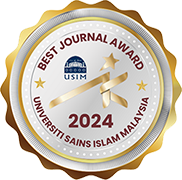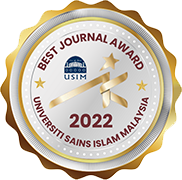نسب ولد اللعان وميراثه : دراسة مقارنة بين الشّريعة الإسلامية والقانون الماليزي
CHILD’S LINEAGE OF AL-LI’AN (OATH OF CONDEMNATION) AND HIS INHERITANCE RIGHTS: A COMPARATIVE STUDY BETWEEN ISLAMIC AND MALAYSIAN LAW
DOI:
https://doi.org/10.33102/mjsl.vol9no1.309Keywords:
Inheritance, Nasab Walad Al- Li`An, Mirathah Walad Al-Li`An,, Genetic PrintAbstract
Abstract in Arabic:
إن نسب ولد اللّعان وميراثه من أبيه الذي نفاه ولاعن على نفيه، يعدّ من المسائل التي لها اعتبارها في الشّريعة والقانون، وذلك لتعدّي الأثر المترتّب على نفي نسبه من أبيه، إلى حرمانه من الميراث من هذا الأب وأسرته، وقد أقرّت بعض المحاكم تحليل البصمة الوراثية عند نفي نسب الولد، وهنا تكمن مشكلة البحث، وذلك فيما إذا نفى الأب الابن وأقرّت نسبه البصمة الوراثية. هدفت هذه الدّراسة إلى التّعريف بولد اللّعان من النّاحية الشّرعية والقانونية، ثم بأهمية تحليل البصمة الوراثية كدليل يعمل به عند تضارب الأقوال بين الزّوج والزّوجة، وقد اعتمدت الدّراسة في هذا البحث على المنهج الاستقرائي وذلك من خلال تتبّع آراء الفقهاء وأدلتهم، والنّظر في سبب الخلاف بينهم، كما اعتمدت على المنهج التّحليلي المقارن في مناقشة آراء الفقهاء وأدلتهم وتحليلها، مع مقارنة هذه الأحكام بما يجري عليه العمل في القانون الماليزي، وقد خلصت هذا الدّراسة إلى نتائج مهمّة منها: أن الولد يبقى على نسب أبيه ما لم ينفه ويلاعن عليه، وأنّ فصل القول عند نفي نسب الولد أو إثباته يرجع إلى تحليل البصمة الوراثية، وأن ولد اللّعان لا ينتفي نسبه وميراثه إلا إذا وافق تحليل البصمة الوراثية قول الزّوج الملاعن.
Abstract in English:
The lineage of al-li`an child and his inheritance from his father, who denied him and performed oath of condemnation (al-mula’anah) is considered one of the crucial issues in the Sharia and the law. This is because of the serious effects of denying his lineage from his father, which leads to depriving the child of the inheritance of the father and his family. Some courts accepted the analysis of the DNA when denying the child's lineage. Based on this fact, the issue has raised, especially when there is a conflict between the father’s denial of his son and the court’s finding based on DNA result. Which one is to be accepted if the father denied while the court confirmed his child’s lineage? This study aimed at introducing al-li`an child from Sharia and legal points of view, and the importance of analyzing the genetic footprint (DNA) as a guide to be used when there is a conflict between husband and wife in their opinions. The research methods used in this study are the inductive approach by tracking the views and evidence of the Islamic jurists and examining the reasons for the disagreement among them. In comparison, the analytical and comparative methods are used to discuss and analyze the opinions of the jurists and their evidence and compare these provisions with what is being practiced in Malaysian law. This study has reached some important results among others: the child of al-li`an remains a legitimate child as long as the father did not deny his lineage. The final decision on denying or confirming child’s lineage is based on the analysis of the genetic fingerprint (DNA result). Therefore, the lineage of al-li’an child and his inheritance right remains valid or undeniable unless the analysis result of the genetic fingerprint conforms with the statement of the father who denied his child lineage through al-li`an (oath of condemnation).
Downloads
References
Ahmad, S. (2016, September 13). 159,725 anak tak sah taraf didaftar sejak 2013: JPN. Berita Harian. https://www.bharian.com.my/berita/nasional/2016/09/192319/159725-anak-tak-sah-taraf-didaftar-sejak-2013-jpn.
Al-‘Lbani, M. 1979. 'Irwa' Al-ghalil Al-Maktab Al'Islami
Al-Bukhari, M. 1998. Ṣaḥiḥ al-Bukhari, Al-Riyad: Bayt Al'afkar.
Al-Jurjani, A.n.d. M’jam Al-Ta’rifat. Cairo: Dar Al-Fadila
Al-Qurra Daqiy A. 2000. Albisma Al-wurathia Min Manthur Al-faqih Al-'islami. Majalat Al-mjm’a Al'islami, no. 16. P. 27-68.
Al-Qurtubi, M. 2006. Al-Jami’ Li'ahkam Al-Quran. Beirut: Mua’sasat Al-risala.
Al-Ragheb, I. n.d. Al-Mufradat Fi Ghariyb Al-Quran. Beirut: Dar Al- ma’rifa.
Al-San’ani, M. 2006. Subul Al-Salam Sharah Bulugh Al-Maram. Al-Riyad: Maktabat Al-Ma’arif
Al-Shatibi, I. 1417. Al-Mwafqat, Al-Su’udia: Dar Ibn ‘affan.
Al-Tirmidhi, M. 1417h. Sunan Al-Tirmidhi. Al-Riyad: Dar ‘Alam Al-Kutub
Al-Zuhaili, W. 1985. Al-faqah Al'Iislami wa'Adlath. Dmshq: Dar Al-fikr.
Arifin, L. 2020, October 22. Pendidikan seksualiti, cegah seks luar nikah. Berita Harian. https://www.bharian.com.my/wanita/keluarga/2020/10/744763/pendidikan-seksualiti-cegah-seks-luar-nikah
Britannica, T. Editors of Encyclopaedia. 2011, December 1. Deoxyribose. Encyclopedia
Britannica. https://www.britannica.com/science/deoxyribose
Darul Ifta. (2009, April 30). Al-Fatawaa-'Ithibat Al-Nisab Bialbisma Al-Warathiya.. Dar-Alifta.Org. https://www.dar-alifta.org/ar/ViewFatwa.aspx?sec=fatwa&ID=12554
Esyariah. (2011). Akta Undang-Undang Keluarga Islam (Wilayah-Wilayah Persekutuan) 1984. Bahagian Viii - Kesahtarafan Anak. Seksyen 114. AKTA 303.
GOV.UK. (n.d). Grounds for divorce. (5 C.E.). GOV.UK. https://www.gov.uk/divorce
Habtoor, F. H. (2018). Hujjiyyt Al-Basma Al-Warathiya fi Al-Ithbat Al-Jinayi. Mağallaẗ Kulliyyaẗ Al-Šarīʿaẗ Wa-al-Qānūn Bi Tantā, 4(33), 1554–1615. https://doi.org/10.21608/mksq.2018.30615
Ibn ‘Abdin, M. 2003. Rada Al-Muhtar. Al-Riyad: ‘Alam Al-kutub
Ibn ‘Ashour, T. 1984. Al-Tahrir Wa Al-Tanwir. Tunis: Al-Dar Al-tuwnisia.
Ibn Abi Shaybah, ‘A. 2004. Al-Musannaf. Al-Riyad: Maktabat Al-Rushd
Ibn Al-Qayyim, H. 1437H. 'I’lam Al-Muaq’iyn ‘An Rab Al-‘Alamin. Maka: Dar ‘Alam Al-Fawa’d.
Ibn Al-Qayyim, H. 1994. Zad Al-ma‘ad. Beirut: Mua’sasat Al-risala.
Ibn Al-Qayyim, H. n.d. Al-Daw' Al-Munir ‘Ala Al-Tafsir. ‘Unyza: Muasasat Al-nuwr Liltiba’a Walnashr
Ibn Faris, H. 1979. Maqayis Al-Lughat. Beirut: Dar Al-fikr.
Ibn Hazm, A. 2009. Al-Mhalla. Beirut: Dar Ihya' Al-Ttrath Al-‘Arabi.
Ibn Hazm, A. 2009. Al-Mhalla. Beirut: Dar Ihya' Al-Ttrath Al-‘Arabi.
Ibn Majah, M. n.d. Sunan Ibn Majah. Al-Riyad: maktab Al-ma‘arif.
Ibn Qudamah, M. 1997. Al-Mugni. Al-Riyad: Dar ‘Alam Al-Kutub
JAKESS. (2019, March). SMY lwn MS (No. 10019–006-0261–2018).. jakess.gov.my. https://jakess.gov.my/pdffile/KoleksiPenghakiman/APR%202019/SMY%20v%20MS.pdf
JAKIM. (2012). Hukum Menggunakan DNA Untuk Menentukan Status Nasab Anak Dan Tempoh Melaksanakan Li’an Untuk Menafikan Nasab Anak.. Jakim : E-Sumber Maklumat Fatwa. http://e-smaf.islam.gov.my/e-smaf/fatwa/fatwa/find/pr/10304.
JAKIM. (2014). Menggunakan DNA Untuk Menentukan Status Nasab Anak Dan Tempoh Melaksanakan Li’an Untuk Menafikan Nasab Anak. JAKIM: E-SMAF V1. http://e-smaf.islam.gov.my/e-smaf/fatwa/fatwa/find/pr/15973
JKSM. Kelantan. (n.d). Li’an. Kelantan. Jksm.Gov.My. Retrieved March 20, 2021, from http://kelantan.jksm.gov.my/jksn/index.php/component/content/article/21-joomla/components/208-li-an?Itemid=951
Li, R., Li, H., Peng, D., Hao, B., Wang, Z., Huang, E., Wu, R., & Sun, H. 2019. Improved pairwise kinship analysis using massively parallel sequencing. Forensic Science International: Genetics, 38, 77–85. https://doi.org/10.1016/j.fsigen.2018.10.006
Muslim, I. (2006). Sahih Muslim. Al-Riyad: Dar Taibah.
Saeid Assadi, A. M. (2014). Nesebin DNA Metodu İle İspat Ve Nefyi. Şarkiyat, 12, 49–85. https://77f7a456-9ef8-47cc-9061-43a46f90e667.filesusr.com/ugd/e0d7bd_d02ca2f1c6ee43febbcf76c0fe3ef64f.pdf
Sultan, S. 2005. Al-Hayat Al-Zawjiya fi Al-Gharb Mushkilat Waqi'iya Wa hulul 'Amaliya, n.p.
Undang-Undang Malaysia. Seksyen 11(1) (2), Akta Kesahtarafan. Seksyen 12(1) (2), Act Hak berkenaan 1979 Act (1961/2006)
Downloads
Published
Issue
Section
License
Copyright (c) 2021 Azziz Raouane, Ruhi Fadzlyana Jailani, Mualimin Mochammad Sahid, Mushaddad Hasbullah

This work is licensed under a Creative Commons Attribution-NonCommercial 4.0 International License.















































